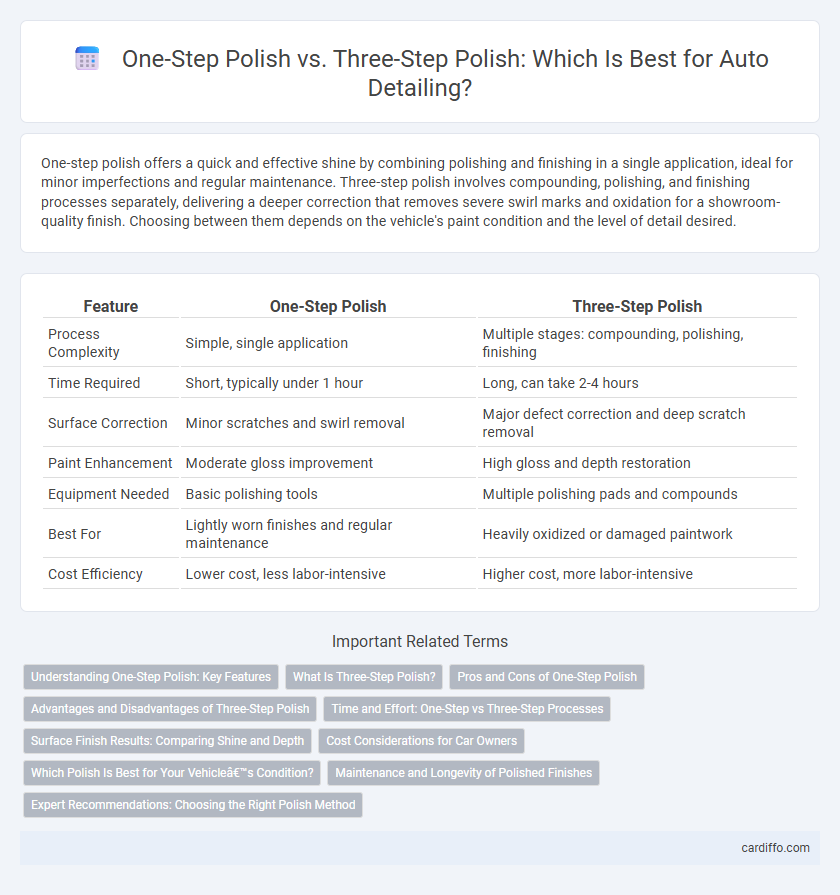One-step polish offers a quick and effective shine by combining polishing and finishing in a single application, ideal for minor imperfections and regular maintenance. Three-step polish involves compounding, polishing, and finishing processes separately, delivering a deeper correction that removes severe swirl marks and oxidation for a showroom-quality finish. Choosing between them depends on the vehicle's paint condition and the level of detail desired.
Table of Comparison
| Feature | One-Step Polish | Three-Step Polish |
|---|---|---|
| Process Complexity | Simple, single application | Multiple stages: compounding, polishing, finishing |
| Time Required | Short, typically under 1 hour | Long, can take 2-4 hours |
| Surface Correction | Minor scratches and swirl removal | Major defect correction and deep scratch removal |
| Paint Enhancement | Moderate gloss improvement | High gloss and depth restoration |
| Equipment Needed | Basic polishing tools | Multiple polishing pads and compounds |
| Best For | Lightly worn finishes and regular maintenance | Heavily oxidized or damaged paintwork |
| Cost Efficiency | Lower cost, less labor-intensive | Higher cost, more labor-intensive |
Understanding One-Step Polish: Key Features
One-step polish combines compounding and finishing into a single process, saving time while effectively removing light to moderate surface imperfections. This method uses a balanced polish formula and specific foam pads designed to produce a glossy finish with minimal swirl marks. Ideal for routine maintenance, one-step polish enhances paint clarity and smoothness without the complexity of multiple polishing stages.
What Is Three-Step Polish?
Three-step polish is a meticulous automotive detailing process that includes compounding, polishing, and finishing stages to remove severe paint defects, swirl marks, and oxidation. Each step uses progressively finer abrasives to restore paint clarity and maximize gloss, often revealing a showroom-quality finish. This method requires more time and skill but delivers superior correction and depth compared to one-step polish.
Pros and Cons of One-Step Polish
One-step polish offers the advantage of faster application and reduced labor, making it ideal for minor paint imperfections and regular maintenance. However, it may lack the depth of correction and finishing quality achievable with a three-step polish, which includes compounding, polishing, and finishing stages. The one-step method can sometimes leave light swirls or holograms, limiting its effectiveness on heavily oxidized or heavily scratched surfaces.
Advantages and Disadvantages of Three-Step Polish
Three-step polish offers superior correction by systematically compounding, polishing, and finishing, effectively removing deep scratches and oxidation for a mirror-like finish, ideal for heavily damaged paint surfaces. This method demands more time and skill, increasing the risk of clear coat damage if improperly applied, making it less suitable for novice detailers or lightly worn paint. The comprehensive process enhances paint clarity and depth but requires specialized tools and products, resulting in higher costs and longer service duration.
Time and Effort: One-Step vs Three-Step Processes
One-step polish significantly reduces time and effort by combining compounding, polishing, and finishing into a single process, making it ideal for quick surface enhancement. In contrast, a three-step polish requires separate stages for heavy correction, refining, and finishing, demanding more skill, time, and multiple tools. Choosing between the two depends on the desired level of paint correction and available time for detailing.
Surface Finish Results: Comparing Shine and Depth
One-step polish delivers a quick, glossy finish ideal for mildly oxidized or lightly scratched surfaces, enhancing shine with minimal effort. Three-step polish involves compounding, polishing, and finishing stages, producing a deeper, more reflective surface ideal for heavily damaged paint. The three-step process achieves superior clarity and depth, removing deeper imperfections compared to the surface-level shine provided by one-step polish.
Cost Considerations for Car Owners
One-step polish offers a cost-effective solution for car owners seeking moderate paint correction and gloss enhancement without multiple product layers. Three-step polish involves higher expenses due to additional compounds, pads, and extended labor for deeper paint correction and superior finish quality. Budget-conscious car owners should weigh the initial cost against the desired level of paint restoration and longevity.
Which Polish Is Best for Your Vehicle’s Condition?
One-step polish is ideal for vehicles with minor surface imperfections, providing a quick and effective shine without extensive labor. Three-step polish offers a more thorough correction process, using compounding, polishing, and finishing to restore deeper scratches and oxidation. Assess your vehicle's paint condition to determine whether a single-stage polish achieves desired results or if a multi-stage process is necessary for optimal restoration.
Maintenance and Longevity of Polished Finishes
One-step polish offers a quicker maintenance option by combining compounding, polishing, and finishing into a single process, which helps maintain shine with minimal effort but may sacrifice some depth and durability. Three-step polish involves separate stages for compounding, polishing, and finishing, delivering a more thorough correction and a longer-lasting, deeper finish that resists oxidation and swirl marks better over time. Regular maintenance after a three-step polish can extend the longevity of the finish by preserving its clarity and reducing the need for frequent re-polishing.
Expert Recommendations: Choosing the Right Polish Method
Experts recommend choosing a one-step polish for light oxidation and minor scratches, as it provides efficient correction with less effort and time. Three-step polish is preferred for severe paint defects and deep scratches, offering a comprehensive approach including compounding, polishing, and finishing stages for optimal clarity. Professionals advise assessing the paint condition and desired results to select the most effective polish method for long-lasting shine and protection.
One-Step Polish vs Three-Step Polish Infographic

 cardiffo.com
cardiffo.com